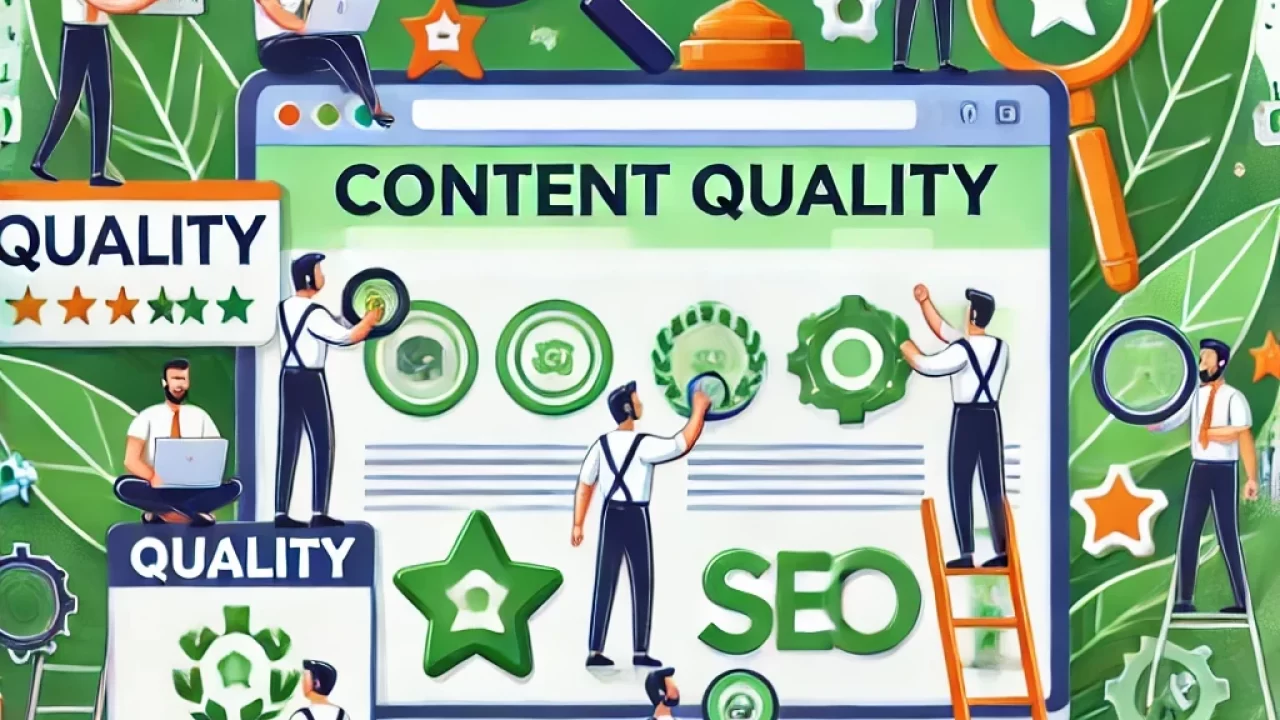Creating great content is crucial for building links and improving your search engine ranking. High-quality content attracts natural backlinks from other websites, which helps boost your SEO. Content quality makes it easier to achieve meaningful link building success.
When your content is valuable and engaging, other sites are more likely to link to it, increasing your domain authority. This, in turn, leads to more organic traffic and better visibility. Quality content helps with links, keeps your audience on your page longer, and encourages them to share it with others.
Key Takeaways
- Quality content attracts natural backlinks
- Valuable content increases domain authority
- Engaging content boosts SEO and audience retention
Unveiling the Link Between Content Quality and SEO
Creating high-quality content is crucial for effective SEO. It not only attracts readers but also earns valuable backlinks.
Defining High-Quality Content
High-quality content is accurate, engaging, and well-researched. It should provide new insights or solutions to a problem. Readers should find it informative and easy to understand.
Structure your content logically. Break it into clear sections with headings. Use bullet points and lists for better readability.
Key elements:
- Relevance: Address the needs and interests of your audience.
- Accuracy: Use reliable sources and verify facts.
- Clarity: Write clearly and concisely.
- Visuals: Include images, videos, or infographics to enhance understanding.
The Role of Content in SEO
Content is essential for improving search engine rankings. Search engines prioritize websites with fresh, relevant, and high-quality content.
Keywords are important. Use them naturally throughout your content. Avoid keyword stuffing, which can harm your rankings.
Key SEO practices:
- Internal linking: Link to other relevant pages on your site to improve navigation.
- External linking: Link to reputable external sources to boost credibility.
- Meta descriptions: Write compelling descriptions to improve click-through rates.
- Mobile optimization: Ensure your content is mobile-friendly.
Content quality influences how often other sites link your page. High-quality content naturally attracts more backlinks, improving your SEO performance.
The Pillars of Content Quality for Link Building
High-quality content is essential for successful link building. Focus on making content relevant, original, and engaging to attract backlinks.
Relevance and Value
Content must be relevant to your audience. This means understanding what your readers are looking for and delivering it. Valuable content answers questions, solves problems, and provides insights.
Tips:
- Know your audience: Research their interests.
- Stay updated: Keep content current.
- Provide solutions: Address common problems.
Relevance and value increase the likelihood that others will link to your content.
Originality and Uniqueness
Unique content sets you apart. If your content offers something new, people are more likely to share it. Originality means not copying others but providing fresh perspectives.
Tips:
- Use original research: Present new data.
- Add personal insights: Share your own experiences.
- Avoid plagiarism: Always credit sources.
Being unique makes your content more appealing for link building.
Engagement and User Experience
Engaging content keeps readers on your page. Users with a good experience are more likely to share your content. Focus on readability and interaction.
Tips:
- Use headings and lists: Break up text.
- Include images and videos: Make it visually appealing.
- Encourage interaction: Prompt comments and shares.
A positive user experience boosts the chances of getting backlinks.
Developing a Content Strategy that Attracts Links
It would be best to focus on research, analysis, and strategic content planning to create a content strategy that attracts links. These steps will help you produce valuable and share-worthy content.
Research and Analysis
Start with keyword research to identify terms your audience is searching for. Use tools like Google Keyword Planner or Ahrefs.
Analyze your competitors. Look at their popular content and see what earns the most links. Understand what topics resonate with your target audience.
Check current trends. Use tools like Google Trends to see what topics are gaining traction. Trends can give you ideas for timely and engaging content.
Collect data on your audience’s interests and behaviors. This can help tailor your content to what they find valuable and shareable.
Strategic Content Planning
Create a content calendar. Plan out your topics, including when and how you’ll publish them. Consistency is key to maintaining audience interest.
Focus on quality over quantity. Publishing less frequently but with higher-quality content that provides value is more likely to earn links.
Consider different formats. Experiment with blog posts, videos, infographics, and podcasts to see what your audience prefers.
Encourage engagement. Ask questions, invite comments, and create shareable content. This interaction can lead to more natural link-building opportunities.
By investing time in careful research and planning, you can develop a content strategy that consistently attracts valuable links.
Techniques for Creating Link-Worthy Content
To create content that attracts links, focus on storytelling and case studies, and leverage data-driven content and infographics.
Storytelling and Case Studies
Stories capture attention and engage readers. Use real-life examples to illustrate your points. Case studies demonstrate success through detailed analysis. Highlight challenges, the strategies you used, and the results. This approach makes your content relatable and credible.
For instance, share a successful marketing campaign you handled. Explain your process, from planning to execution. Show tangible results like increased traffic or sales. Use quotes or testimonials to add authenticity. Break up text with bullet points or lists to make it more readable.
Data-Driven Content and Infographics
Data-focused content adds authority. Conduct original research or use reliable sources. Present your findings. Infographics are visual tools that simplify complex information. They are easy to share and often attract backlinks.
Create charts or graphs to depict data trends. Use them to support your arguments. Ensure the design is clean and professional. Include sources for credibility. An infographic about industry trends can make your content stand out and encourage others to link to it.
Leveraging High-Quality Content for Link Acquisition
Creating great content can help you gain more backlinks by making promoting and building relationships with key influencers easier.
Outreach and Promotion
To attract links, start with outreach. Find sites relevant to your content. Use tools like BuzzSumo or Ahrefs to see who links to similar content. Craft a personalized email highlighting the value your content provides. Keep it short and engaging.
Use social media to spread your content. Please share it on platforms like Twitter, LinkedIn, and Facebook. Tagging relevant people or organizations can boost visibility. Joining forums or discussion groups related to your niche can also drive attention to your content.
Building Relationships with Influencers
Influencers in your niche can help promote your content. Begin by identifying key influencers using tools like Followerwonk or Traackr. Engage with their content by commenting or sharing their posts. This builds rapport before you ask for a favor.
When reaching out, personalize your message. Explain why your content is valuable and how it can benefit their audience. Offer to collaborate on future projects to build long-term relationships.
Regularly update your network with high-quality content to maintain interest and establish yourself as a reliable source of valuable information.
Measuring the Impact of Content on Link Building
High-quality content plays a massive role in earning backlinks and improving SEO. It would be best to look at how to analyze backlink profiles and measure content performance.
Analyzing Backlink Profiles
Backlink profiles show the quality and quantity of links pointing to your content. Tools like Ahrefs or Moz help you track these links.
Key factors to consider:
- Total number of backlinks: More links often signal more trust and authority.
- Link diversity: Links from various domains boost credibility.
- Anchor text relevance: Relevant anchor text improves PageRank and context.
Regularly monitor these factors to understand how well your content builds links.
Content Performance Metrics
To measure content effectiveness, track specific metrics. Google Analytics and other SEO tools can provide insights.
Important metrics:
- Organic traffic: An increase in traffic shows effective SEO.
- Engagement rates: High engagement indicates valuable content.
- Social shares: More shares often mean more backlinks.
Check these metrics often to see if your content strategies are working. Adjust your plans based on data to improve results continually.
Overcoming Challenges in Content-Driven Link Building
There needs to be more than just crafting quality content; managing link building expectations and adapting to search engine algorithm changes are key components.
Managing Link Building Expectations
Setting realistic goals for link building is important. Only some pieces of content will gain significant traction immediately. Your quality content must be promoted strategically to attract attention. Outreach is crucial; you must contact influencers and related industry websites to share your content.
Understand that link building is a long-term strategy. Create a schedule for evaluating link performance. Analyze metrics like backlink count, referral traffic, and domain authority regularly. Address underperforming content by updating or repurposing it.
Remember that building links from highly reputable sources may take time. Persistence in outreach and maintaining a high content standard are essential for ongoing success.
Adapting to Algorithm Changes
Search engine algorithms continuously evolve, affecting how links impact rankings. Keep updated with algorithm changes from major search engines like Google. This helps make informed adjustments to your content and link building strategies.
Avoid black-hat SEO tactics, as they can incur penalties. Focus on genuine, value-driven content to maintain strong links. Monitor industry blogs, forums, and Google’s Webmaster Central Blog for updates on best practices.
Flexibility is key. Be prepared to tweak your content strategy to align with new algorithm preferences. Maintain a diverse link profile to safeguard against fluctuations in ranking criteria.
By staying informed and adaptive, you can better navigate the evolving landscape of content-driven link building.
Conclusion
High-quality content plays a critical role in link building.
By focusing on producing valuable content, you can attract more backlinks. This leads to better search engine rankings and more organic traffic.
To achieve success, prioritize content relevance and credibility. Use a well-planned content strategy to ensure sustained growth.
Remember, consistency in delivering quality content is crucial for lasting results. Your dedication to excellence will build trust and authority in your industry.
Frequently Asked Questions
High-quality content attracts backlinks, boosts SEO strategies, influences the authority of inbound links, and increases organic link acquisition rates. Relevance also plays a crucial role.
What are the key characteristics of high-quality content that attract backlinks?
High-quality content is original, well-researched, and insightful. It provides value, addresses target audience needs, and is easy to read. High-quality content includes relevant visuals and is well-structured with headers, bullet points, and short paragraphs.
How does producing quality content contribute to a sustainable SEO strategy?
Producing quality content helps build a strong foundation for long-term SEO success. It attracts natural backlinks, earns audience trust, and improves website authority. Quality content encourages repeat visits and shares, enhancing your site’s visibility.
Can the quality of content influence the authority of the inbound links it attracts?
Yes, the quality of content can directly influence the authority of the links it attracts. High-quality content is more likely to be linked by reputable sites, improving your site’s overall authority and trustworthiness.
What role does content quality play in the rate of organic link acquisition?
Quality content significantly increases the rate of organic link acquisition. Readers are more likely to share and link to content that they find useful, interesting, and credible. This leads to more natural backlinks over time.
How can content creators ensure high-quality content is optimized for link building?
Content creators should focus on in-depth research, clear writing, and addressing specific audience needs. Use SEO best practices like keyword optimization, meta descriptions, and internal linking. Engaging headlines and quality visuals also boost readability and shareability.
How does content’s relevance impact its effectiveness in garnering links?
Relevant content meets the interests and needs of your target audience. It is more likely to be shared and linked by others in your niche. Relevance ensures that the content resonates with readers and drives more organic links.






